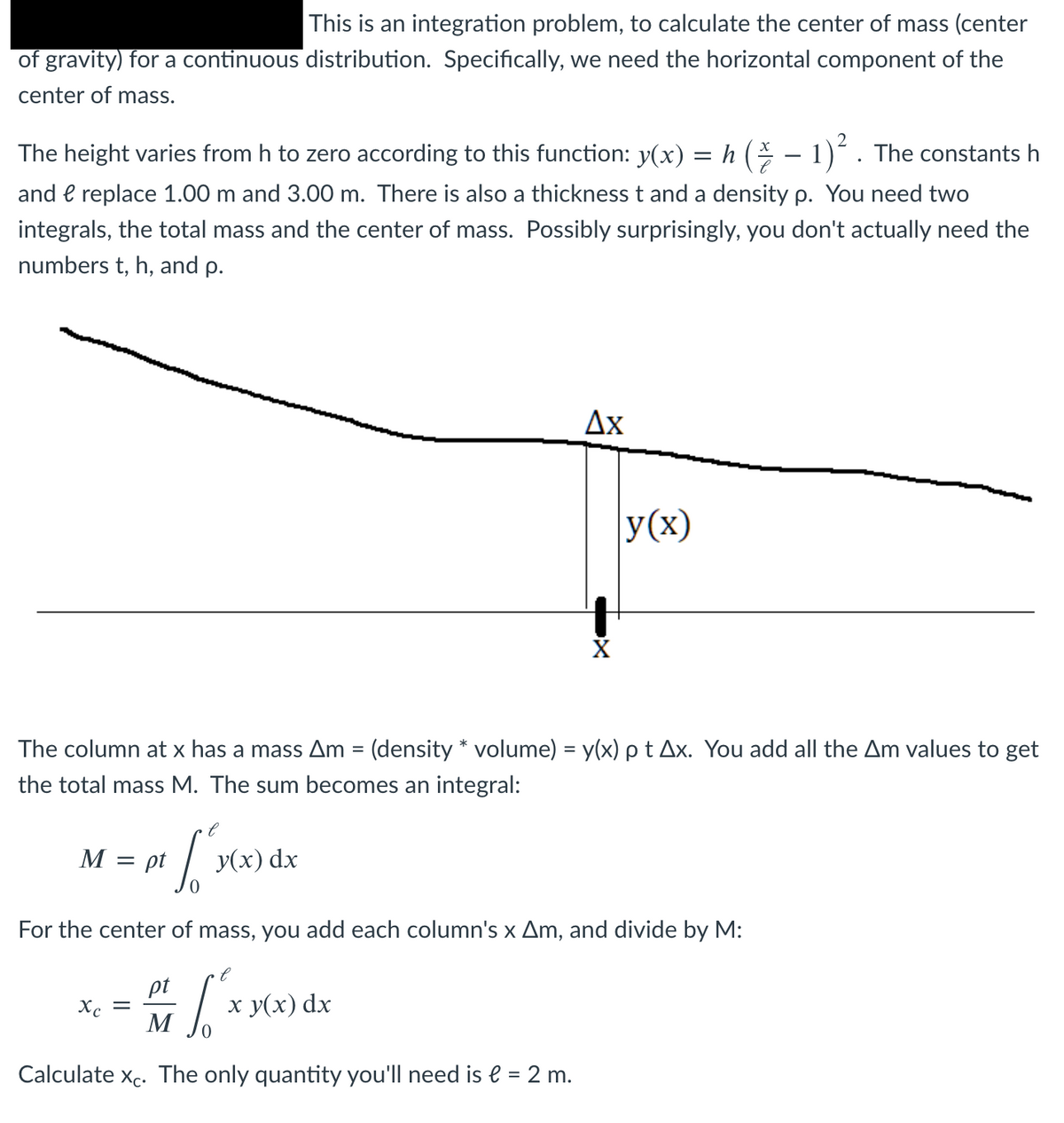This is an integration problem, to calculate the center of mass (center of gravity) for a continuous distribution. Specifically, we need the horizontal component of the center of mass. The height varies from h to zero according to this function: y(x) = h ( – 1)´ . The constants h and e replace 1.00 m and 3.00 m. There is also a thickness t and a density p. You need two integrals, the total mass and the center of mass. Possibly surprisingly, you don't actually need the numbers t, h, and p.
This is an integration problem, to calculate the center of mass (center of gravity) for a continuous distribution. Specifically, we need the horizontal component of the center of mass. The height varies from h to zero according to this function: y(x) = h ( – 1)´ . The constants h and e replace 1.00 m and 3.00 m. There is also a thickness t and a density p. You need two integrals, the total mass and the center of mass. Possibly surprisingly, you don't actually need the numbers t, h, and p.
Classical Dynamics of Particles and Systems
5th Edition
ISBN:9780534408961
Author:Stephen T. Thornton, Jerry B. Marion
Publisher:Stephen T. Thornton, Jerry B. Marion
Chapter10: Motion In A Noninertial Reference Frame
Section: Chapter Questions
Problem 10.12P
Related questions
Question

Transcribed Image Text:This is an integration problem, to calculate the center of mass (center
of gravity) for a continuous distribution. Specifically, we need the horizontal component of the
center of mass.
The height varies from h to zero according to this function: y(x) = h ( – 1)´ . The constants h
and e replace 1.00 m and 3.00 m. There is also a thickness t and a density p. You need two
integrals, the total mass and the center of mass. Possibly surprisingly, you don't actually need the
numbers t, h, and p.
Ax
y(x)
The column at x has a mass Am = (density * volume) = y(x) p t Ax. You add all the Am values to get
%3D
the total mass M. The sum becomes an integral:
M :
= pt
У(x) dx
For the center of mass, you add each column's x Am, and divide by M:
pt
Xc =
M
х у(x) dx
Calculate xc. The only quantity you'll need is e = 2 m.
Expert Solution
This question has been solved!
Explore an expertly crafted, step-by-step solution for a thorough understanding of key concepts.
This is a popular solution!
Trending now
This is a popular solution!
Step by step
Solved in 4 steps

Knowledge Booster
Learn more about
Need a deep-dive on the concept behind this application? Look no further. Learn more about this topic, physics and related others by exploring similar questions and additional content below.Recommended textbooks for you

Classical Dynamics of Particles and Systems
Physics
ISBN:
9780534408961
Author:
Stephen T. Thornton, Jerry B. Marion
Publisher:
Cengage Learning

University Physics Volume 1
Physics
ISBN:
9781938168277
Author:
William Moebs, Samuel J. Ling, Jeff Sanny
Publisher:
OpenStax - Rice University

Principles of Physics: A Calculus-Based Text
Physics
ISBN:
9781133104261
Author:
Raymond A. Serway, John W. Jewett
Publisher:
Cengage Learning

Classical Dynamics of Particles and Systems
Physics
ISBN:
9780534408961
Author:
Stephen T. Thornton, Jerry B. Marion
Publisher:
Cengage Learning

University Physics Volume 1
Physics
ISBN:
9781938168277
Author:
William Moebs, Samuel J. Ling, Jeff Sanny
Publisher:
OpenStax - Rice University

Principles of Physics: A Calculus-Based Text
Physics
ISBN:
9781133104261
Author:
Raymond A. Serway, John W. Jewett
Publisher:
Cengage Learning